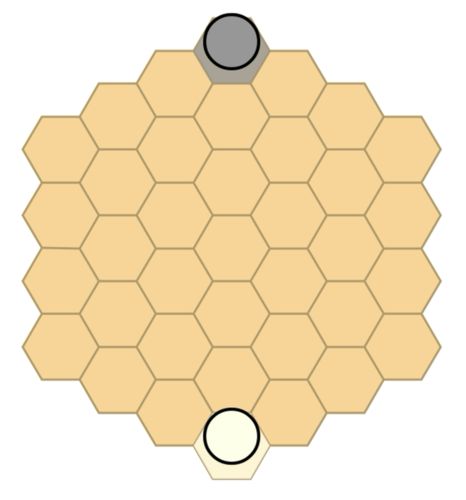|
Advertisement
|
Seesaw

DescriptionSeesaw is a Draughts-inspired elimination game, played on a hexhex board of size 4 or 5. Each player needs, in their own color, a large number of stackable tokens and tiles. Rules Overview: The central idea of Seesaw is the 2-fold significance of stack-size: This results in soldiers seesawing up and down the board as their strength increases to the point where the game is forced to conclude in one side completely eliminating the other. How to play: 1. Placing a new stack: 2. Moving a stack: 2.1 Noncapturing moves: On turns where you do not have to capture an enemy (see below) all the steps a stack takes is either constrained to the 3 upward directions ("forwards") or to the 3 downward directions ("backwards"), depending on the parity of the size of the stack. Up and down have their standard meanings for games where players sit on opposite sides of a board, like in Draughts and Chess. 2.2 Capturing moves: If one or more of your stacks can reach an enemy by lifting the restraint on direction, you must capture such a reachable enemy by replacement. If that stack did not spend all its steps reaching the captured enemy, you can, before you end your turn, spend the left-over steps by making a noncapturing move. However, if yet an enemy is in range immediately after you have captured (counting only the steps left over), you must capture again. 3. Promoting: Your odd-sized stacks promote when they end up on a promotion cell belonging to your opponent at the end of your turn. Your even-sized stacks promote when they end up on a promotion cell belonging to you at the end of your turn. When a stack promotes, you add 1 piece to it. The object of Seesaw is to capture all your opponent's soldiers. More precisely: If, at the end of your turn, your opponent has no stacks on the board, you have won the game. Game DiscussionsAdd CommentYou need to be logged in to comment. Insert Bullet List Please enter at least one item. Item: Item: Item: Item: Item: Insert Numeric List Please enter at least one item. Item: Item: Item: Item: Item: Insert Link Please enter the link of the website Optionally you can add display text Insert Email Please enter the email address Optionally add any display text Insert Image Please enter the link of the image Insert YouTube Video Please enter the link of the video Marketplace | ||||

Comments (0)